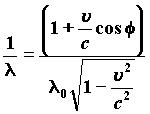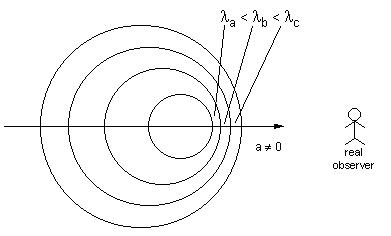|
|
|
The behavior of waves and sources is determined by mutual interactions among waves, and between waves and sources. The particle’s mass energy,:
6) Em = m c2
is equal to Planck's wave energy attributable to the elementary waves constituting its field
7) Ep = h n
It follows that:
8) m c2 = h
n
Expressing the equality of the two energies in terms of wavelenght:
9)

The particle having rest mass m0, has a wavelenght l0, which is equal to Compton wavelenght.
10)

The particle-wave source at rest has in any direction in its vicinity the same wavelenght; the wave field has a spherical symmetry and for an ideal observer it emits elementary spherical waves.
An ideal observer who observes the motion of this particle in his frame of reference, verifies the existence of a wave number deriving from relativistic Doppler effect which enables him to represent the particle as in Fig. 3.
The ideal observer verifies
a wavelength l1
< l0,
that is shorter than that of the particle at rest, when the target angle
compared to the particle’s direction is Ø = 0.
11)

When the angle is Ø
= p,
he observes a wavelenght l2
> l0,
that is greater than that of the particle at rest.
A real observer, unlike
the ideal observer, verifies only some variations in the wave energy of
elementary waves. When he observes a sudden
acceleration of the particle, he can verify the existence of a wave train
emission
formed by a certain number
of wavefronts. The speeder the particle-wave
source is, the shorter the wavelenght of the wavefronts is.
This wave train formed by waves of different wavelenght will never be monochromatic and the real observer will call it “photon”.
There are therefore two types of energy: the wave energy of elementary waves whose existence can be deduced but not perceived, and the energy formed by the variation in the energy of elementary waves, that we can verify through our senses and instruments and to which all of us react.
There is nothing mysterious in the hypothesis of the existence of the elementary waves and their energy. Nevertheless, we have to verify if the introduction of this hypothesis in physics is able to improve our comprehension of physical phenomena and of the theories supporting them.
With this view, let us admit that the symmetry properties of the field of the particle-wave source is an essential condition for the existence of the particle considered as an integral part of its energy and potential field.
Let us introduce a variation in wave energy in the vicinity of the particle considered as a perturber of the state of wave symmetry of its field.


